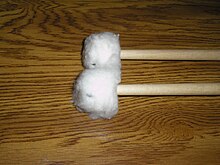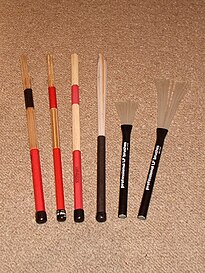Percussion mallet
This articlerelies largely or entirely on asingle source.(April 2021) |

Apercussion malletorbeateris an object used to strike or beat apercussion instrumentto produce its sound.
The term beater is slightly more general. A mallet is normally held in the hand while a beater may be a foot or mechanically operated, for example in abass drum pedal.The term drum stick is less general still but still applied to a wide range of beaters. Some mallets, such as atrianglebeater, are normally used only with a specific instrument, while others are used on many different instruments. Often, mallets of differing material and hardness are used to create differenttimbreson the same types of instrument (e.g. using either wooden or yarn mallets on axylophone).
Some mallets, such asvibraphonemallets, are normally just called mallets, others have more specialized names including:
- Drum sticks,of many types, some used with a wide variety of instruments,.
- Rutes,used with many instruments.
- Brushes, used particularly withsnare drumbut also with many other instruments.
- Tippersused to strike abodhrán.
- Bachi,used with Japanesetaikodrums.
- Hammers, used to striketubular bells
Types
[edit]Drum sticks
[edit]Drum sticks are beaters normally used in pairs, with each held in one hand, and are similar to or derived from thesnare drumsticks that were subsequently adopted forkit drumming.
They are the most general-purpose beaters, and the term covers a wide variety of beaters, but they are mainly used for untuned percussion.

Mallets
[edit]
As well as being a general term for a hand-held beater,malletis also used specifically to refer to a hand-held beater comprising aheadconnected to a thin shaft, and used in pairs. There is a wide selection of mallets to choose from to create a desired sound, articulation, character, and dynamic for the pieces being played.[1]Professional percussionists typically have a good selection of mallets on hand to be prepared for each piece. There are three main types:
- Unwrapped mallets,used onglockenspiel,xylophone,and other instruments with keys made of durable material, have heads made ofbrass,rubber,nylon,acrylic,wood,or other hard materials.
Timpani mallets 
Brushes in use on asnare drum Rutes and nylon brushes - Wrapped mallets,mostly used onmarimba,vibraphone,and other instruments with softer keys (though they can be used on more durable instruments as well), have heads ofkelon,rubber, nylon, acrylic, or other medium-hard materials wrapped in softer materials like yarn, cord or latex. Wrapped mallets are also the mallets of choice to playsuspended cymbal,though drum set players will typically use drum sticks instead.
- Feltmalletsorcartwheel malletshave heads composed of layers of felt, held between two steel washers. They are mainly used on untuned percussion as well as ontimpani.
Mallet shafts are commonly made ofrattan,birch,or synthetic materials such asfibreglass.Birch is stiff and typically longer, while rattan is a more flexible shaft and gives a more open sound. Fiberglass is ideal for playing lightly on an instrument because it is easy to control.
Different mallets are used primarily to alter thetimbreof the mallet instrument being played. Generally, mallets composed of softer materials will stick to the instrument for longer as they bounce off of it, which gives a deeper sound made up of lower frequencies. Harder materials tend to bounce off quicker, and as they stick to the instrument for a shorter amount of time, they tend to be able to excite more of the higher frequencies, giving the sound a higher pitch with more overtones. Mallet's choice is typically left up to the performer, though some compositions specify if a certain sound is desired by the composer.
Players frequently employ two mallets in a matched grip or four mallets in a four-mallet grip; however, the use of up to six mallets is not uncommon. More than two mallets may be used even when nochordsare called for by the composer so that the performer has a wider range of timbres from which to select or to facilitate the performance of music that moves rapidly between high and low, and if hit properly can switch between the twopitches.
If the mallet is too hard, the instrument may be damaged. For example, onrosewoodmarimbas, certain mallets may be too hard, increasing the risk of a cracked bar.
Brushes
[edit]Brushes are a set of bristles connected to a handle so that the bristles make a rounded fan shape. They are often used injazzorbluesmusic, but also in other genres such asrock,country,andpop.The bristles can be made of metal or plastic; the handles are commonly made of wood or aluminum and are often coated with rubber. Some brushes are telescoping so that the bristles can be pulled inside a hollow handle and the fan made by the bristles can be of variable length, width, and density. Retracting the bristles also protects the brush when it is not being used. The non-bristled end of the brush may end in a loop or a ball.
Rutes
[edit]A route or multi-rod consists of several thin sticks that are bound together to form one stick. Its sound is midway between a stick and a brush.
Long used in orchestral music, in the mid-20th century routes also became popular for many other purposes includingkit drummingandbodhrán.
By dissipating much of the energy of the stroke within the stick, a route allows a drummer to achieve both a tone and a playing action that would normally be associated with a quite loud playing, but at a moderate or even low volume. The tone produced by many can be adjusted by adjusting the position of one of the bands holding the bundle together.
Major percussion mallet companies
[edit]See also
[edit]References
[edit]- ^Peters, Kyle (7 May 2019)."How to Choose the Right Mallet".Yamaha Educator Suite.Retrieved23 March2021.
External links
[edit]- Accessory FetishA Complete List of Drumstick Manufacturers
- Traditional letter/number schemefor snare drum stick model names


